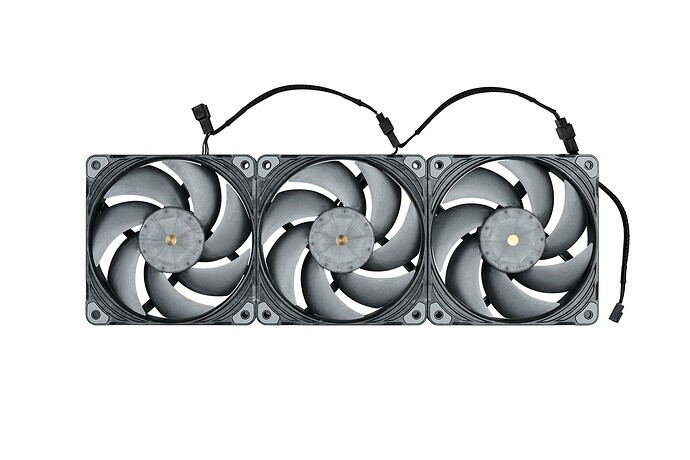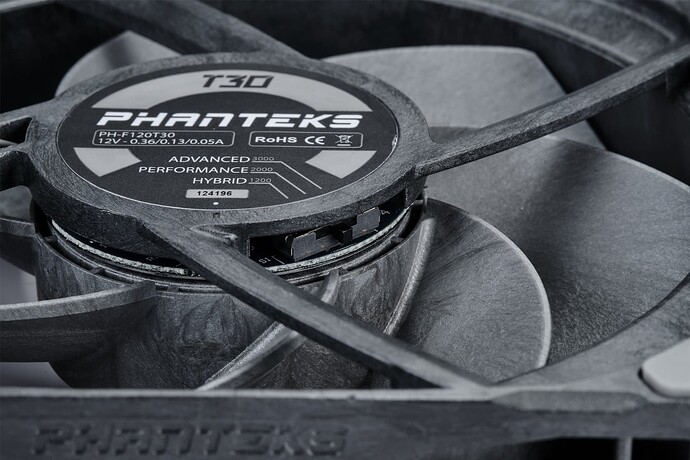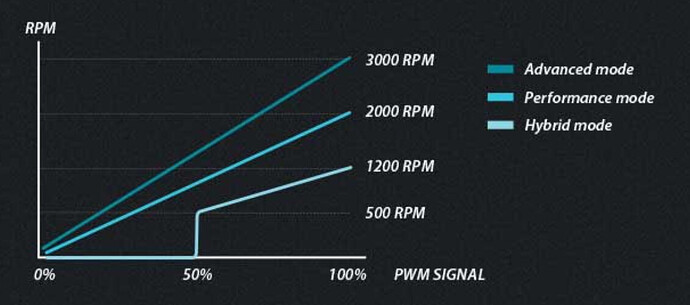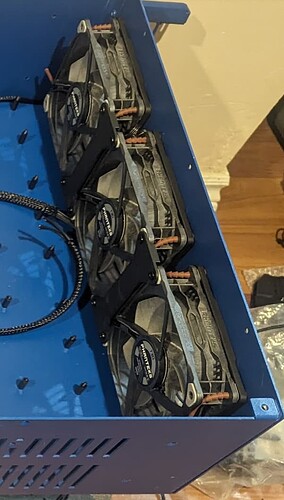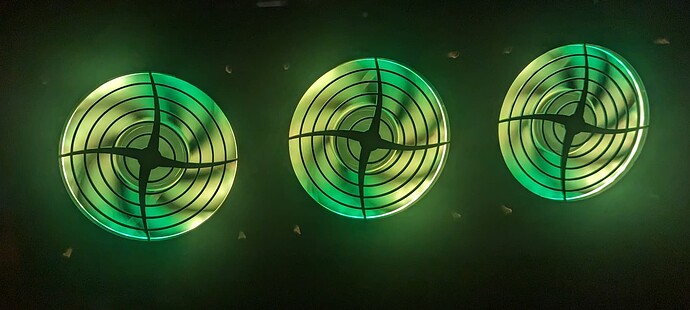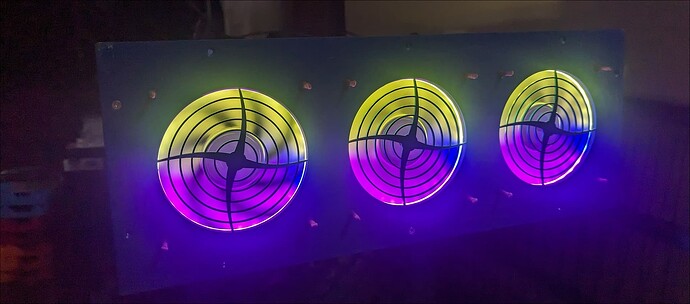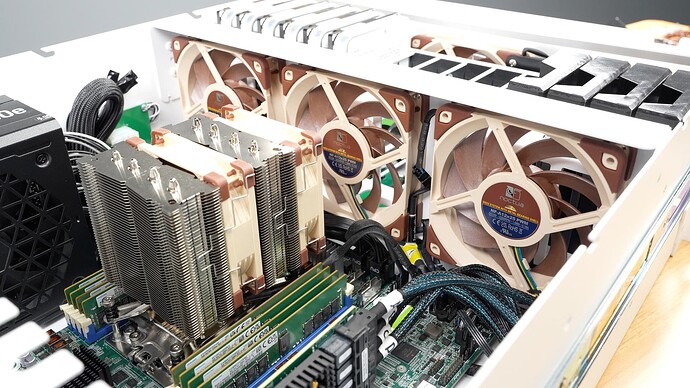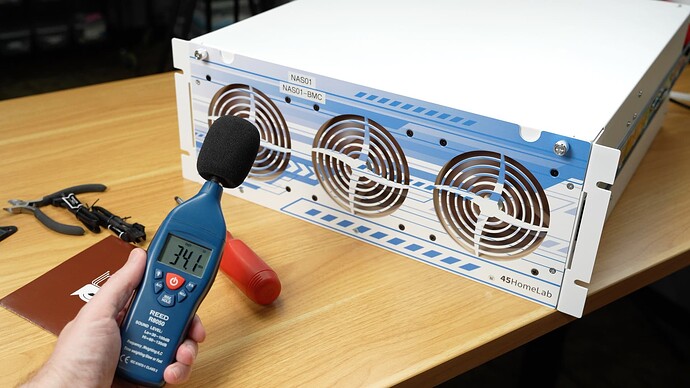You could replace the spot the current static fan power breakout exists.
I bought ARCTIC fans (Amazon.com) and controller (Amazon.com) to replace the originals. I just have it floating in the case near the power supply not hard mounted. So far I’m happy with them, it’s much better from a noise perspective.
It is unfortunate that the case comes with fans that aren’t controllable when it appears alternate options exist for a minimal additional cost. Also frustrating is the OEM fan power cables aren’t able to be unplugged from the power board so I ended up cutting the plugs off the OEM fans to protect the power pins so they wouldn’t be just floating around bare. I couldn’t bring myself to cut the wires off the main power harness.
I still think the HL15 is probably the best (only?) option out there with the HDD backplane, just wish I could get 100% behind it with no misgivings.
Could you take a picture of your setup?
this isn’t full related, if someone needs a temporary fix to quiet the HL15 down a bit, you can take off the front panel and disconnect the front rack of fans and then reattach the front panel, good amount of airflow still and definitely quieter. I was going to do the arctic fans and PWM controller exactly like Brandon until this change was enough till I move where I can put it in a storage room and reattach the front row of fans
So is there a consensus on the best fan upgrade for the fully built HL15? As many have already reported in here, the stock configuration is way too loud for the typical home.
The problem isn’t the fans per se, it is the way they are wired (2-pin direct from PSU).
The OEM fans are 3-pin so can be VDC speed controlled, but the OEM motherboard only supports 4-pin PWM fan speed control through IPMI.
You could change the fans to other 3-pin ones that will run constantly at a lower RPM as their top speed, but I don’t consider that “best” technically or financially. This limits you in your ability to do upgrades, as the lower RPM may not support the additional heat load when you go to upgrade.
“Best” really depends on your budget and future plans for the HL15. If all you’re going to do is plug in some 3.5 inch drives and not add any additional heat load like a GPU, extra NIC, extra HBA, CPU upgrade, 2.5 inch drive caddy, etc., then you can knock down the speed of the stock fans with a CPU fan low noise resistor or 3-pin fan hub with its own speed control. This approach, though, also assumes a fairly consistent workload since the fans won’t be ramping up and down with temperature changes.
The “best” long term upgrade, assuming you will expand and upgrade the system, is probably to replace the stock fans with PWM fans and connect them to the headers on the motherboard so they can be controlled by system temperatures. In this case, the particular brand probably doesn’t matter as much; Noctua, Arctic, etc.
In my case, I kept the stock fans and connected them to my motherboard which supports both VDC and PWM fan control. But I only purchased the Case+CPU, not the full build. My understanding is this isn’t possible with the X11SPH motherboard.
Exactly, the “quiet cable” mods are reducing the fan noise sure, but also reducing their cooling ability. And while that would totally work with the lower end power devices, in the case of a built with much more heat it would be greatly detrimental to both performance and longevity of hardware. Being its a 4U rack case, and most people probably will use it in that manner, I don’t know why the fans are going to be an issue if its in a rack in a closet or basement. Mine will be on a “shelf” next to me till i have cable pulled throughout the house, and it might be loud, but that kind of comes with the territory of servers.
BTW mine was delivered like 2hrs after I left the state, cant wait to get home to start working on it.
I disagree with these sentiments a bit. If “most” people will rack it, then I would expect rails to be included in the price. The fact is, the case design is such that rails are sold separately, the rack ears are optionally attachable, and feet are provided to orient the case tower-style under a desk. Use as a workstation chassis was a design use case, but the pedal-to-the-metal fans don’t really honor that use case. One can say the passive CPU heat sink on the full build requires more out of the chassis fans, but here again the chassis is offered for sale sans motherboard, so someone doing their own build should have easier access to the fan wiring through a hub or without cutting wires to connect them to fan headers on a motherboard.
A chassis with six 120mm fans should not need to be server-room loud to move a good volume of air. A lot of server equipment uses 40mm or 80mm fans so needs higher RPMs to move more air. Also, although noise may not be a primary consideration, those Dells and HPs and IBMs and Netapps and Supermicros do ramp the fans up and down based on load to some degree and do not operate them at a constant 100%.
I had a Q30 ten years ago that sat on its side in my office near my desk and it wasn’t particularly loud. I don’t have access to it right now, so I can’t compare how it was wired, but I’d be very surprised if it had the same wiring driving the fans at a constant 2300 RPM. Now, it wasn’t whisper quiet, but I didn’t feel I needed to put on NC headphones to kill the noise. People wanting to put this in their living room entertainment centers are being unrealistic, but I don’t think those wanting to put it in their office are. If that was an unreasonable expectation then I think the marketing and/or market analysis around the HL15 were a bit off.
The fact is, the case design is such that rails are sold separately, the rack ears are optionally attachable, and feet are provided to orient the case tower-style under a desk. Use as a workstation chassis was a design use case, but the pedal-to-the-metal fans don’t really honor that use case.
I get where you are coming from, i just seen so many of the homelab community (especially reddit) having interesting takes on the HL15 in particular. So I have kind of figured a lot of the complaints of sound were as you say “in the living room” type scenarios. Plus when I do see pics of them posted I personally see them in racks far more than tower orientation. Its entirely possible less than 5% are rack mounted, and that I’m only stumbling on the 5% that are. I don’t know if anyone has exact statistics on what way their are being used.
I’m glad it supports both, only wish it had holes for mounting the feet for landscape orientation until I have cable run in the walls, mine must sit on a large shelf in landscape, and hoping I don’t tear of the real wood too much without feet. I am likely going to be cutting up a yoga mat to put on the shelve to protect the wood, or disassemble the HL-15 to drill/tap holes for the feet to go in landscape. Because it will move to a rack eventually, I will like use the yoga mat method.
A chassis with six 120mm fans should not need to be server-room loud to move a good volume of air. A lot of server equipment uses 40mm or 80mm fans so needs higher RPMs to move more air. Also, although noise may not be a primary consideration, those Dells and HPs and IBMs and Netapps and Supermicros do ramp the fans up and down based on load to some degree and do not operate them at a constant 100%.
Not sure on the Q30, but I remember reading the fans in the commercial 45 drives units were all Noctuas, not sure if that’s 100% accurate, also not sure if they were wired the same, or if they used variable speeds. There is a post here showing how someone did what looked like a simple mod to add a wire to control them as you mentioned, and I wonder if it would be something 45Drives could change in future builds painlessly, and maybe offer the leads with extra wires to those with machines already.
My old PC used to have 2pin fans that ran 100% but lower CFM and Noise than my new PC. New PC is all PWM fans, and if its idle its silent, if I’m encoding with steady high CPU/GPU load its loud, and if it’s in between it ramps up and down constantly which is FAR worse to me than just loud and steady. I can block out the noise of the steady 2000rpm, the ramping is very irritating even if it’s only ramping from 0rpm to 500rpm and back to 0rpm. Everyone has their own expectations. And I expect some tuning to the fans for each build, but I also don’t like the ramping, so I would have preferred a simple speed potentiometer on the power PCB. PWM seems to be what a majority of posts I read wish to have.
I will also say I have considerable hearing loss from my pass employment, so loud to me may be REALLY loud to some others.
@DigitalGarden @ZarZ thanks for all of the information. That fan wire mod seems like the most elegant solution if sticking with the stock fans, albeit a litte janky if one has to solder the extra wires. Has there been any mention on whether 45drives will provide it as a mod kit?
For the foreseeable future, I will be using my HL15 as a backup target for my Synology, TrueNAS , proxmox servers, and to store NVR footage. So I think I should still be ok with the passive cooling on the CPU even if I reduce the speed of the fans.
Noctua NF-P12 redux-1700 PWM. Same/better stats, but much quieter and 4-wire PWM.
If it’s a Supermicro board, you’ll need to tweak the IPMI sensor thresholds to stop them from spinning up/down every few seconds. Just make sure the thresholds are appropriate so you don’t run the fans too low. Watch your temps and adjust as needed.
Supermicro Fans Are Repeatedly Ramping Up and Down | Stefandroid Blog
Thanks, I have ordered the Noctua PWM fans and will hook them up directly to the motherboard. Will post results once installed!
I don’t have a HL15, I’m building out a old bare Storage Pod Chassis.
I went with Phanteks T30s.
They are the successor to the Corsair MLs (sunon magnetic levitating bearing) and are built using a similar polymar as Noctuas. They are +5mm thicker than your standard 120mm.
Stats can be found here
https://www.phanteks.com/PH-F120T30.html
They have built in daisy chain capability so less cable mess to deal with.
Switchable profiles that adjust the fan curve based on your pwm signal.
Static pressure: 1.27mm H₂O on hybrid, 3.30 Performance and 7.11 Advanced.
My build has been paired with the Phanteks Halos, cause RGB gives +10 to cooling stats.
I recently added the T30s to my spreadsheet of fans that I was looking at for my HL15. They have some of the lowest static pressure out of any of the fans I have listed but at the expense of some noise, they move A TON of air. Pretty good fans overall.
Just did a fan swap (disclaimer: Noctua sent these fans to me, I did not pay for them), put in 6x Noctua NF-A12x25 PWM fans, plus one NA-FH1 fan hub, and bypassed all the fan connections that were built into the chassis. I plugged the three front fans into the fan hub using the included fan extension cables, and the other three fans directly into a three-way fan splitter in the motherboard. The three front fans are also spaced just out from the front face using NA-IS1 fan spacers.
The cable management for the CoolerGuys fans was so nice, I felt bad snipping the zip ties and removing the nice 3D printed cable guides… but it had to be done!
Before, from 1’ in front of the chassis, the CoolerGuys Fans at 100% would reach around 60 dBa. Now, with the Noctua fans going into the motherboard (and fan hub, which is plugged into another motherboard header), I’m getting 34 dBa.
HUGE reduction in sound, and besides working through an issue in the ASRock Rack BIOS, it’s working out great. Much more pleasant to be around, and now I can hear the hard drives when they’re writing data ![]()
Thanks @geerlingguy for posting this (and for your amazing YouTube channel!). The noise levels were stopping me from buying the HL 15, but with this fan upgrade, I may go ahead and pull the trigger.
Any particular reason you chose the specific NF-A12x25 fans?
Also, what is the point of the fan spacers for the front fans? Will the fans not work without the spacers?
I recently swapped the stock fans for some Noctua NF-F12 iPPC 3000 PWM high static pressure fans I had left over from a previous server. They’re not the quietest at full bore but they run around 500 RPM at idle. Big improvement in sound, around 35dB, and is noticeably quieter than the nearby chest freezer.
For the moment I have them all connected to a no-name fan controller which ramps speed based on CPU temp. I’m watching HDDs during scrubs to make sure they keying off the CPU temp keeps them cool enough.
Edit: to add, they also save me almost 10 watts.
How hard is the fan upgrade? I am a little apprehensive about taking it apart but the noise is pretty bad. I feel like it’s worse than my 24 bay diskshelf (downgrading/upgrading lol) has anyone seen a video on line doing the replacement.
There are a few YouTube videos where the fans are replaced, but all of them just have some short B-roll and voiceover, not a detailed guide.
It’s honestly not that hard though. The three front fans are screwed to the faceplate, so to access those you can undo the seven screws on the front of the unit. The fans mid-chassis are screwed to the piece of metal that runs across the case behind the backplane and drives and that is secured in with two screws on each side of the outside of the case. The tails for the fans go back to some short leads from the power distribution board on the right wall of the case, so unplug them there.
How you proceed then depends on which “mod” you want to do.
a) You can plug resistor cables between the PDB and the existing CG fans to lower the constant RPM and airflow and call it a day
b) If your mobo supports 3-pin DC fan control you can plug the existing CG fans into your mobo. I don’t think the full build mobos support DC fan control (but could be wrong).
c) Unscrew and replace the 120mm CG fans with non-RGB PWM fans of your choosing from Noctua, Arctic or some other brand. In this case you will be undoing the cable management of the long fan tails that HL has done for the CG fans. Run your fan’s own tails under the backplane or off to the side from the front based on whatever your level of patience and OCD for cable management is. To connect 6 fans you will likely need some sort of hub, fan-out or daisy-chain cable like one of these;
https://forum.45homelab.com/t/i-recommend-this-100-fan-mod/958/25?u=digitalgarden
d) Unscrew and replace the 120mm CG fans with RGB fans. I can’t help with the details of this, but TechnoTim’s video might help. You will probably need to get some sort of RGB or ARGB controller depending on the RGB capabilities of your motherboard and what inputs you want controlling the RGB.
If you leave the fan connectors from the PDB disconnected (b, c, d), you should probably put some electrical tape around them to prevent a short, and tuck them away.
Put the mid chassis fan wall back in with its screws and the front faceplate back on with its screws. They are probably the same screw, but I don’t remember.
Thank you for such a great description. I think I am leaning towards Option C or D. I definitely wouldn’t have known about the electrical tape. If I go towards RGB, can that be regulated within Unraid or the Bios? I wouldn’t imagine so but curious if you or others know. Sounds like it’s going to be another 2 or 3 week project LOL
